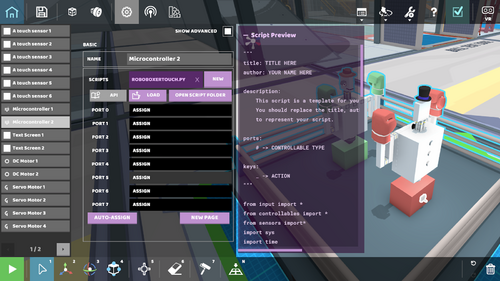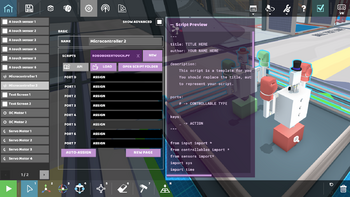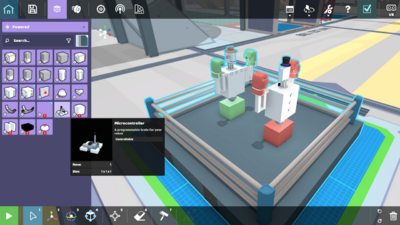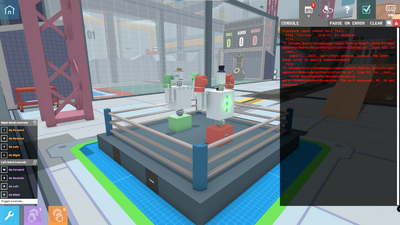Coding: Difference between revisions
Tag: Reverted |
m (Protected "Coding" ([Edit=Allow only administrators] (indefinite) [Move=Allow only administrators] (indefinite))) |
||
| (33 intermediate revisions by 5 users not shown) | |||
| Line 1: | Line 1: | ||
[[File:Microntroller Code Preview Example.png|thumb|500px|Microcontroller Interface]] | [[File:Microntroller Code Preview Example.png|thumb|500px|Microcontroller Interface]] | ||
==Getting Started== | ==⚙ Getting Started== | ||
Programming is | Programming is complex, especially when you don't know where to start. For those without access to programming classes or extracurriculars via their learning institution, RoboCo recommends [https://www.codecademy.com/learn/learn-python?utm_source=pepperjam&utm_medium=affiliate&utm_term=215171&clickId=4023389168&pj_creativeid=8-12462&pj_publisherid=215171 CodeAcademy's Learning Python]. This course is a great way to learn the fundamentals of Python AND is fully virtual, so players can take classes whenever they want. | ||
In addition to learning the language, | In addition to learning the language, players will also need a program to code in. RoboCo recommends [https://code.visualstudio.com/ Visual Studio Code] and its accompanying [https://marketplace.visualstudio.com/items?itemName=ms-python.python Python extension]. This is the program RoboCo developers use to write code for RoboCo. It comes with a variety of different customization options and extensions to fit all your coding needs (including Java and C++). You can also try [https://notepad-plus-plus.org/downloads/ Notepad++] and [https://www.sublimetext.com/ Sublime] if Visual Studio Code is of little interest or isn't available. | ||
Additionally, RoboCo requires players to use its custom API Documentation. This is the way in which players "talk" to their robots and includes instructions for how to program the different sensors and other controllable parts within the game. | Additionally, RoboCo requires players to use its custom API Documentation. This is the way in which players "talk" to their robots and includes instructions for how to program the different sensors and other controllable parts within the game. Players can access the API [https://docs.roboco.co/latest/ here] or by clicking the API button in the Microcontroller interface within RoboCo. | ||
[[#top|Back to Top]] | |||
Sensors | ==⚙ Current Available Sensors== | ||
Sensors are programmable parts that allow a robot to interpret the physical world into processable data. Think of them as the robot equivalent to a human's eyes or ears. The robot can be instructed via code to take actions based on the sensor data it receives, which is what allows a robot to complete tasks on its own (like delivering a sandwich across a crowded restaurant or launching a soda can across a room). | |||
Below is a list of all the sensors currently available in the game. Other parts that can be controlled with Python can be found on the [[Controls]] page. | |||
{| class="wikitable" | {| class="wikitable" | ||
| Line 23: | Line 25: | ||
|Touch Sensor | |Touch Sensor | ||
|[[File:Touch Sensor Icon 2.png|50px]] | |[[File:Touch Sensor Icon 2.png|50px]] | ||
|A part that sense touch input | |A part that sense touch input. | ||
|- | |- | ||
|Force Sensor | |style="background-color:#ECECEC;" | Force Sensor | ||
|[[File:Force Sensor.png|50px]] | |style="background-color:#ECECEC;" | [[File:Force Sensor.png|50px]] | ||
|A part that senses the forces applied to it along 6 axes | |style="background-color:#ECECEC;" | A part that senses the forces applied to it along 6 axes. | ||
|- | |- | ||
|Inertial Sensor / IMU | |Inertial Sensor / IMU | ||
|[[File:Inertial Motion Sensor Icon.png|50px]] | |[[File:Inertial Motion Sensor Icon.png|50px]] | ||
|A sensor for measuring acceleration, rotation, and angular velocity | |A sensor for measuring acceleration, rotation, and angular velocity. | ||
|- | |- | ||
|Distance Sensor | |style="background-color:#ECECEC;" | Distance Sensor | ||
|[[File:Distance Sensor.png|50px]] | |style="background-color:#ECECEC;" | [[File:Distance Sensor.png|50px]] | ||
|A part that senses the distance to the first object it encounters | |style="background-color:#ECECEC;" | A part that senses the distance to the first object it encounters. | ||
|- | |- | ||
|Color Sensor | |Color Sensor | ||
|[[File:Color Sensor Icon.png|50px]] | |[[File:Color Sensor Icon.png|50px]] | ||
|A camera that senses the color in front of it | |A camera that senses the color in front of it. | ||
|- | |- | ||
|} | |} | ||
==How to Load a New or Completed Script== | [[#top|Back to Top]] | ||
==⚙ How to Load a New or Completed Script== | |||
[[File:Microntroller Code Preview Example.png|thumb|350px|RoboCo Code Preview]] | |||
[[ | The first step to accessing the programming interface in RoboCo is attaching the microcontroller to a robot. This is the "brain" of a robot, and this can be found in the Powered section of the [[Parts]] inventory. | ||
Once players have added a microcontroller to their robot, they can either hit the "New" button to create a new script or the "Load" button to upload a previous or already completed script from their desktop. Currently, all scripts for RoboCo live in a folder called "Scripts" which players can access via the "Open Script Folder" button or by going to This PC --> Documents --> my games --> RoboCo --> (Your Steam Username) --> Scripts. | |||
Once | Once players have loaded in their code correctly, they'll see a preview of it in the microcontroller interface. | ||
[[#top|Back to Top]] | |||
==How to Assign Ports== | ==⚙ How to Assign Ports== | ||
RoboCo has two options when assigning ports: manual or automatic. If | RoboCo has two options when assigning ports: manual or automatic. If players want to automatically map their ports, simply click the auto-assign button in the microcontroller interface. If they want to manually map their ports, follow the instructions below: | ||
{| class="wikitable" | {| class="wikitable" | ||
| Line 64: | Line 70: | ||
|- | |- | ||
|Step 1 | |Step 1 | ||
|Add the microcontroller to | |Add the microcontroller to a robot to access the script interface. | ||
|[[File:Select the MicroController Example.png|400px]] | |[[File:Select the MicroController Example.png|400px]] | ||
|- | |- | ||
|Step 2 | |style="background-color:#ECECEC;" | Step 2 | ||
|Choose to either create a new script or load an already-created script | |style="background-color:#ECECEC;" | Choose to either create a new script or load an already-created script. | ||
|[[File:Loading a Previous Script Example.png|400px]] | |style="background-color:#ECECEC;" | [[File:Loading a Previous Script Example.png|400px]] | ||
|- | |- | ||
|Step 3 | |Step 3 | ||
|Assign | |Assign parts to ports manually or use the “automatically assign” button. | ||
|[[File:Assinging Ports Example.png|400px]] | |[[File:Assinging Ports Example.png|400px]] | ||
|- | |- | ||
|Step 4 | |style="background-color:#ECECEC;" | Step 4 | ||
|Press the play button (or spacebar) to run | |style="background-color:#ECECEC;" | Press the play button (or spacebar) to run the code. If an error occurs, use the in-game debug console to help troubleshoot. | ||
|[[File:RoboCo Debug Console Example.png|400px]] | |style="background-color:#ECECEC;" | [[File:RoboCo Debug Console Example.png|400px]] | ||
|- | |- | ||
|} | |} | ||
==Troubleshooting== | [[#top|Back to Top]] | ||
==⚙ Importing External Scripts== | |||
The RoboCo Python Interpreter searches a few places for libraries by default. The main location is <your Steam directory>\steamapps\common\RoboCo\RoboCo_Data\StreamingAssets\Robocode\python\Lib. The game's code libraries are stored here. | |||
Adding a file to the Lib directory will allow you to import it from any script in your robots, however, the Lib folder could get reset in the future, and it's inconvenient to set up libraries in the folder over the Scripts folder where the scripts for all of your robots (including ones from the workshop) are stored. | |||
The Scripts folder is located far within the user's Documents folder and is not searched for libraries by default. The following code segment adds the Scripts folder to the list of folders to look for libraries in. | |||
<pre> | |||
import os, sys | |||
path = str(os.path.expanduser('~'))+'\\Documents\\My Games\\Roboco' | |||
if not os.path.isdir(path): path = str(os.path.expanduser('~'))+'\\My Documents\\My Games\\Roboco' | |||
if os.path.isdir(path): | |||
for file_path in os.listdir(path): | |||
for folder in os.listdir(os.path.join(path, file_path)): | |||
f_path = os.path.join(path, file_path, folder) | |||
if(os.path.isdir(f_path) and folder == 'Scripts'): | |||
if not (f_path in sys.path): sys.path.append(f_path) | |||
else: | |||
print('*Error finding Roboco folder*') | |||
</pre> | |||
After the path is added, the files within the Scripts folder can be imported like any other file would be. | |||
Importing a script from another known directory is simple, too. | |||
For example, on my computer (your steam directory might be different), this code will allow me import a file from the RoboCo game folder. | |||
<pre> | |||
import sys | |||
sys.path.append('C:\Program Files (x86)\Steam\steamapps\common\RoboCo') | |||
</pre> | |||
[[#top|Back to Top]] | |||
==⚙ Troubleshooting== | |||
RoboCo has a debug console built into its coding interface that allows players to see what lines of code are causing errors. This should be | RoboCo has a debug console built into its coding interface that allows players to see what lines of code are causing errors. This should be the first step in helping troubleshoot Python code. | ||
If | If players encounter a more complicated situation, there is a #coding-and-automation-help-desk channel in the [https://discord.gg/mS8zUKMkwV Official RoboCo Discord], which is meant to help troubleshoot more complicated behaviors. Once players have submitted a question to the channel, a member of RoboCo's dev team or an equally knowledgeable Discord member should respond with guidance on how to solve the problem. | ||
[[#top|Back to Top]] | |||
Latest revision as of 20:59, 19 July 2023
⚙ Getting Started
Programming is complex, especially when you don't know where to start. For those without access to programming classes or extracurriculars via their learning institution, RoboCo recommends CodeAcademy's Learning Python. This course is a great way to learn the fundamentals of Python AND is fully virtual, so players can take classes whenever they want.
In addition to learning the language, players will also need a program to code in. RoboCo recommends Visual Studio Code and its accompanying Python extension. This is the program RoboCo developers use to write code for RoboCo. It comes with a variety of different customization options and extensions to fit all your coding needs (including Java and C++). You can also try Notepad++ and Sublime if Visual Studio Code is of little interest or isn't available.
Additionally, RoboCo requires players to use its custom API Documentation. This is the way in which players "talk" to their robots and includes instructions for how to program the different sensors and other controllable parts within the game. Players can access the API here or by clicking the API button in the Microcontroller interface within RoboCo.
⚙ Current Available Sensors
Sensors are programmable parts that allow a robot to interpret the physical world into processable data. Think of them as the robot equivalent to a human's eyes or ears. The robot can be instructed via code to take actions based on the sensor data it receives, which is what allows a robot to complete tasks on its own (like delivering a sandwich across a crowded restaurant or launching a soda can across a room).
Below is a list of all the sensors currently available in the game. Other parts that can be controlled with Python can be found on the Controls page.
⚙ How to Load a New or Completed Script
The first step to accessing the programming interface in RoboCo is attaching the microcontroller to a robot. This is the "brain" of a robot, and this can be found in the Powered section of the Parts inventory.
Once players have added a microcontroller to their robot, they can either hit the "New" button to create a new script or the "Load" button to upload a previous or already completed script from their desktop. Currently, all scripts for RoboCo live in a folder called "Scripts" which players can access via the "Open Script Folder" button or by going to This PC --> Documents --> my games --> RoboCo --> (Your Steam Username) --> Scripts.
Once players have loaded in their code correctly, they'll see a preview of it in the microcontroller interface.
⚙ How to Assign Ports
RoboCo has two options when assigning ports: manual or automatic. If players want to automatically map their ports, simply click the auto-assign button in the microcontroller interface. If they want to manually map their ports, follow the instructions below:
⚙ Importing External Scripts
The RoboCo Python Interpreter searches a few places for libraries by default. The main location is <your Steam directory>\steamapps\common\RoboCo\RoboCo_Data\StreamingAssets\Robocode\python\Lib. The game's code libraries are stored here.
Adding a file to the Lib directory will allow you to import it from any script in your robots, however, the Lib folder could get reset in the future, and it's inconvenient to set up libraries in the folder over the Scripts folder where the scripts for all of your robots (including ones from the workshop) are stored.
The Scripts folder is located far within the user's Documents folder and is not searched for libraries by default. The following code segment adds the Scripts folder to the list of folders to look for libraries in.
import os, sys
path = str(os.path.expanduser('~'))+'\\Documents\\My Games\\Roboco'
if not os.path.isdir(path): path = str(os.path.expanduser('~'))+'\\My Documents\\My Games\\Roboco'
if os.path.isdir(path):
for file_path in os.listdir(path):
for folder in os.listdir(os.path.join(path, file_path)):
f_path = os.path.join(path, file_path, folder)
if(os.path.isdir(f_path) and folder == 'Scripts'):
if not (f_path in sys.path): sys.path.append(f_path)
else:
print('*Error finding Roboco folder*')
After the path is added, the files within the Scripts folder can be imported like any other file would be.
Importing a script from another known directory is simple, too.
For example, on my computer (your steam directory might be different), this code will allow me import a file from the RoboCo game folder.
import sys
sys.path.append('C:\Program Files (x86)\Steam\steamapps\common\RoboCo')
⚙ Troubleshooting
RoboCo has a debug console built into its coding interface that allows players to see what lines of code are causing errors. This should be the first step in helping troubleshoot Python code.
If players encounter a more complicated situation, there is a #coding-and-automation-help-desk channel in the Official RoboCo Discord, which is meant to help troubleshoot more complicated behaviors. Once players have submitted a question to the channel, a member of RoboCo's dev team or an equally knowledgeable Discord member should respond with guidance on how to solve the problem.







